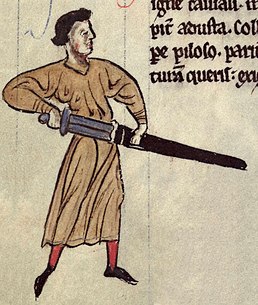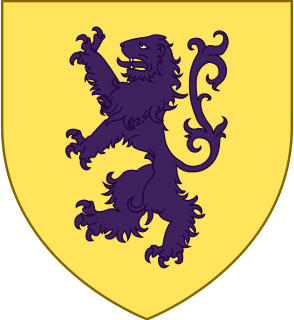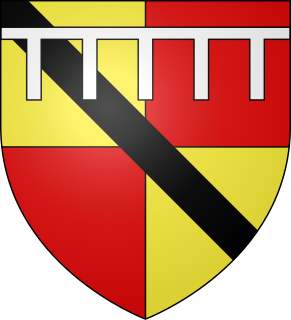| |||||
| Centuries: | |||||
|---|---|---|---|---|---|
| Decades: | |||||
| See also: | Other events of 1172 List of years in Ireland | ||||
Events from the year 1172 in Ireland.
| |||||
| Centuries: | |||||
|---|---|---|---|---|---|
| Decades: | |||||
| See also: | Other events of 1172 List of years in Ireland | ||||
Events from the year 1172 in Ireland.
Walter de Lacy (d.1241) Lord of Meath.

Trim Castle is a castle on the south bank of the River Boyne in Trim, County Meath, Ireland, with an area of 30,000 m2. Over a period of 30 years, it was built by Hugh de Lacy and his son Walter as the caput of the Lordship of Meath. The Irish Government currently own and are in charge of the care of the castle, through the state agency The Office of Public Works (OPW).

The title of Earl of Ulster has been created six times in the Peerage of Ireland and twice in the Peerage of the United Kingdom. Since 1928, the title has been held by the Duke of Gloucester and is used as a courtesy title by the Duke's eldest son, currently Alexander Windsor, Earl of Ulster. The wife of the Earl of Ulster is known as the Countess of Ulster. Ulster, one of the four traditional provinces of Ireland, consists of nine counties: six of these make up Northern Ireland; the remainder are in the Irish Republic.

John's First Expedition to Ireland refers to a visit to the Island of Ireland by John Plantagenet as part of a campaign to secure the influence of the House of Plantagenet and the Crown of England, who planned to set up a Kingdom of Ireland within the Angevin Empire. John was himself a future King of England, the son of Henry II of England and had been declared Lord of Ireland by his father at the Council of Oxford in 1177. Despite his own ambitions for the Kingdom of Jerusalem, John Lackland was sent west to Ireland by his father and landed at Waterford in April 1185.

Meath was a kingdom in Ireland from the 1st to the 12th century AD. Its name means "middle," denoting its location in the middle of the island.

The Anglo-Norman invasion of Ireland took place during the late 12th century, when Anglo-Normans gradually conquered and acquired large swathes of land from the Irish, over which the kings of England then claimed sovereignty, all allegedly sanctioned by the Papal bull Laudabiliter. At the time, Gaelic Ireland was made up of several kingdoms, with a High King claiming lordship over most of the other kings. The Norman invasion was a watershed in Ireland's history, marking the beginning of more than 800 years of direct English and, later, British, involvement in Ireland.

de Lacy is the surname of an old Norman family which originated from Lassy, Calvados. The family took part in the Norman Conquest of England and the later Norman invasion of Ireland. The name is first recorded for Hugh de Lacy (1020–1085). His sons, Walter and Ilbert, left Normandy and travelled to England with William the Conqueror. The awards of land by the Conqueror to the de Lacy sons led to two distinct branches of the family: the northern branch, centred on Blackburnshire and west Yorkshire was held by Ilbert's descendants; the southern branch of Marcher Lords, centred on Herefordshire and Shropshire, was held by Walter's descendants.
Morgallion is one of the baronies that comprise county Meath, Ireland.
Events from the year 1177 in Ireland.

Hugh de Lacy, Lord of Meath, 4th Baron Lacy, was an Anglo-Norman landowner and royal office-holder. He had substantial land holdings in Herefordshire and Shropshire. Following his participation in the Norman Invasion of Ireland, he was granted, in 1172, the lands of the Kingdom of Meath by the Anglo-Norman King Henry II, but he had to gain control of them. The Lordship of Meath was then the most extensive liberty in Ireland.

Hugh de Lacy, 1st Earl of Ulster was an Anglo-Norman soldier and peer. He was a leading figure in the Norman invasion of Ireland in the 12th century, and was created Earl of Ulster in 1205 by King John of England.

Walter de Lacy was lord of Meath in Ireland. He was also a substantial land owner in Weobley, Herefordshire, in Ludlow, Shropshire, in Ewyas Lacy in the Welsh Marches, and several lands in Normandy. He was the eldest son of Hugh de Lacy, a leading Cambro-Norman baron in the Norman invasion of Ireland, and Rohese of Monmouth.
Jocelyn de Angulo, 1st Baron of Navan, was an Anglo-Norman knight.
Events from the year 1181 in Ireland.
Maud de Lacy, Baroness Geneville was a Norman-Irish noblewoman and wealthy heiress who inherited half the estates of her grandfather Walter de Lacy, Lord of Meath, upon his death in 1241. The lordships of Trim and Ludlow passed to her second husband Sir Geoffrey de Geneville, 1st Baron Geneville by right of his marriage to her; although she helped to rule and administer the estates in an equal partnership. She is sometimes referred to as Matilda de Lacy.
Ratoath is a barony in County Meath. It comprises ten parishes and portion of two others viz Rathbeggan, Dunshaughlin, Kilbrew, Crickstown, Killegland, Cookstown, Donaghmore, Ratoath, and portions of Ballymaglasson and Trevit.
The Lordship of Meath was an extensive seigneurial liberty in medieval Ireland that was awarded to Hugh de Lacy by King Henry II of England by the service of fifty knights and with almost royal authority. The Lordship was roughly co-extensive with the medieval kingdom of Meath. At its greatest extent, it included all of the modern counties of Fingal, Meath, Westmeath as well as parts of counties Cavan, Kildare, Longford, Louth and Offaly. The Lordship or fiefdom was imbued with privileges enjoyed in no other Irish liberty, including the four royal pleas of arson, forestalling, rape, and treasure trove.
Events from the year 1252 in Ireland.
Nicholas Devereux of Chanston (Vowchurch) was an Anglo-Norman nobleman living during the reigns of John and Henry III of England. The Devereux were a prominent knightly family along the Welsh Marches during the thirteenth century, and Nicholas Devereux was a key member of the retinue of Walter de Lacy, Lord of Meath.

John fitz Richard was an Anglo-Norman soldier, Baron of Halton and hereditary Constable of Chester. Historical records refer to him as "John, Constable of Chester". He died at Acre in the Holy Land.

An Act for the division of Meath into two shires was an Act of the Parliament of Ireland passed in 1542 which resulted in the division of County Meath, shired in 1297, into the counties of Meath and Westmeath. The Act commenced on Saint Catherine's Day in 1542 and remains in effect.